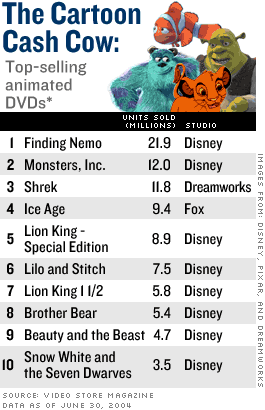NEW YORK (CNN/Money) -
The Walt Disney Co. has just released one of its most anticipated flicks of the year. To find it in theaters, though, movie buffs will have to travel back in time -- 12 years, to be exact.

That an aging title like "Aladdin," the 1992 Arabian Nights adaptation that came out on DVD Tuesday, is enjoying top billing is a reminder of the terrible year Disney is having at the box office.
It also shows, however, just how deftly Disney continues to manage its vast library of animated films.
"Disney's been very astute" at warding off challenges and maximizing its animation library, said Gerry Kaufhold, an analyst with In-Stat/MDR, a Scottsdale, Ariz.-based market research firm.
But times may be changing. Disney's lock on the animated movie market is growing weaker as competitors rush in, crowding the field and driving down DVD prices. New technologies also threaten its dominance.
Kaufhold estimates that sales of digital video disks in the United States will reach $14 billion in 2004, more than triple the level four years ago. In fact, DVD sales have become bigger moneymakers for studios than box office draws.
With consumer appetite seemingly insatiable and fat profit margins, Kaufhold said the industry mantra generally has been "to milk" movie titles with multiple DVD releases.
A lesson in marketing 101
Disney is the second-biggest player in the DVD market behind Warner Bros. (a sister company of CNN/Money), according to Video Store Magazine. For the first six months of this year, Disney home video -- including live action and animation -- reaped nearly $1.3 billion in revenues.
When it comes to animation, the studio has stuck to the marketing strategy that paid off big since VHS cassettes first arrived.

It involves releasing "special," "limited" and "collector's" editions of classic films for short periods, then discontinuing their production for several years thereafter. The DVD version of "Aladdin," for instance, will be taken out of print in January, after just three months.
In this way, Disney cycles through its animated film library every seven to 10 years. Scott Hettrick, editor-in-chief of DVD Exclusive, said a big moneymaker for Disney has been the "platinum" editions of its top 10 best-selling home videos, including "Aladdin."
Disney recently accelerated its "Platinum Collection" production schedule to twice a year (next up: "Bambi" in March 2005). The idea is to take advantage of the DVD craze before a new high-definition format comes out. If, as expected, consumers upgrade their DVD stash, the entire sales cycle begins anew.
Consumers, accustomed to instant gratification, may not like Disney's timed-release strategy. But they put up with it because the titles are well-loved. And every decade there's a whole new crop of kids to entertain.
"It's very smart marketing," said Gerry Kaufhold, the In-Stat/MDR analyst.
What's more, pent-up demand helps Disney maintain pricing levels. According to Video Store magazine, the average price of a DVD has fallen to about $15. "Aladdin" sells at Amazon for $32.49 -- which is still 35 percent off its retail price.
In fact, according to Bob Chapek, president of Disney's Buena Vista Home Entertainment, Disney's animated films, some more than half a century old, are selling at higher prices today than they did 10 years ago.

Chapek declined to disclose Disney's animated film revenues. But combining DVD and VHS sales, the top four best-selling home videos of all time are Disney animated films, based on units sold.
Another benefit for Disney: it can time releases of its animated film library to help offset bad years at the box office.
In 2004, for instance, as the company's movies have bombed in theaters, Disney has rolled out more special editions or new direct-to-video versions of old animations. One direct-to-video released this winter, "Lion King 1 1/2," is now the seventh best-selling animated film of all time.
Too much of a good thing?
For all its success, Disney's formula faces some grave threats. While still a tiny business today, video-on-demand could one day cut into the DVD cash cow throughout the film industry. Like other studios, Disney has done only limited experiments with digital movie downloads, none of which have involved its animation titles.
For now, the biggest risk to Disney's fairytale DVD story is -- aside from piracy -- mounting competition. Disney rivals are flooding into the animation field. In fact, where Disney long had a lock on animated films, DreamWorks' "Shrek" and "Ice Age" from Twentieth Century Fox are No. 3 and No. 5 on the list of the top 10 best-selling animation DVDs.
Another Disney title is bound to fall when "Shrek 2" comes out on DVD early next month.
 |
YOUR E-MAIL ALERTS
|
Follow the news that matters to you. Create your own alert to be notified on topics you're interested in.
Or, visit Popular Alerts for suggestions.
|
|
|
The more animated films there are on the market, the more choices consumers have to buy non-Disney titles and the higher the pressure on Disney to compete with lower prices.
"Their biggest threat is glut of product, when suddenly parents and kids have too many animated film products available to them," said Hettrick.
Disney's Chapek, for one, doesn't sound at all worried.
"I'm not suggesting (the home video gold mine) is going to last forever," he said. "For the near future, it's a pretty good bet."

|

